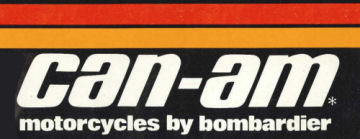

| Classic CanAm |
MX-1 Restoration Project |
Section 2: The Engine |
| The engine had blown up, apparently
from a blockage in the oil reservoir feed line. Early CanAm's had a foam baffle in
the backbone reservoir which sometimes deteriorated, leaving loose particles which find
their way into the oil line. CanAm sent out a service bulletin regarding this
problem in the 70's but apparently the original owner didn't get the news. Fragments
of the piston were embedded in the cylinder head and the liner was shot. The original head proved to be unusable and needed to be replaced. I had contemplated having the old head welded up and re-machined, but it would have been very expensive. By using the connections I've made through the CanAm website, I was able to locate an early style used head from Mike Burnham in Connecticut. Mike is another CanAm fanatic and was nice enough to dig through his old parts buckets and pull out a head in good condition. The 1973-74 125 MX-1 cylinder is unique among the 125cc Rotax motors. The fins are not slotted like the later 125's and externally resemble the 175 and 250. The very early 73's also use a 15mm wrist pin which this bike had. It probably wouldn't make a difference if the 15mm pistons were readily available, but they are a bit more difficult to findn Fortunately I was able to acquire an 18mm rod so I could used the later style piston. Fred supplied a new cylinder sleeve and piston with the bike which I had fit by a local machine shop. This allowed me to keep the standard bore so I could start out fresh. While the machinist had his hands on the cylinder I instructed him to open the exhaust and finger ports to MX-2 specs. We couldn't match the porting specs exactly because there is not enough metal around the MX-1 cylinder exhaust area. I was never one to second guess the CanAm engineers and screw around with reliability, but in this case it paid off with a dramatic increase in horsepower. The MX-1 claims 20 HP, but after riding the bike with the modified porting, pipe, and R/V, I'd say we're pushing about 25+. And because of the rotary valve, we were still able to maintain a much wider powerband than the Elsinore's which dominate the vintage 125 class. The rotary valve was cut to specs from an old CanAm
racing bulletin (same as the MX-2). Carburetion was accomplished via
Bing. In my experience, the old Bing provides more horsepower than the later
Mikuni's and is much easier to fine tune. The only modification I made was the
installation of a choke instead of a tickler. Jetting was kept at 155 main, and 40
pilot, which are stock sizes at sea level for an MX-2. This may eventually change,
but I needed a baseline to start with. The external flywheel Bosch ignition was replaced with a Motoplat unit. There is really nothing wrong with the Bosch unit, but my cousin wanted the bike to have "explosive" power. One way I knew to accomplish this was to use the internal flywheel Motoplat ignition. It gives quick revs and higher RPM. The only problem with the internal flywheel is that you have to pay close attention to the clutch in tight turns or slow sections to prevent stalling the small engine. But when the power hits . . . you know it! The original pipes on the MX-1 and early TNT's fall
into the "super hokie" category. They have a large flat
silencer/spark-arrestor that fits behind the side panel and are extremely heavy.
Although it worked okay in 1973, there is no way to clean years of carbon buildup from the
muffler. Lubrication I've heard mixed opinions by a number of qualified CanAm experts regarding the use of oil injection, and read various service bulletins on modifying the engine to accept pre-mixing. Some people say to take off the pump and pre-mix. Other's say that pre-mixing alone will starve the main bearings since the engine was designed for an oil injection system. My own experience is that oil-injection is very reliable and will make the Rotax motor last far longer than pre-mixing. |